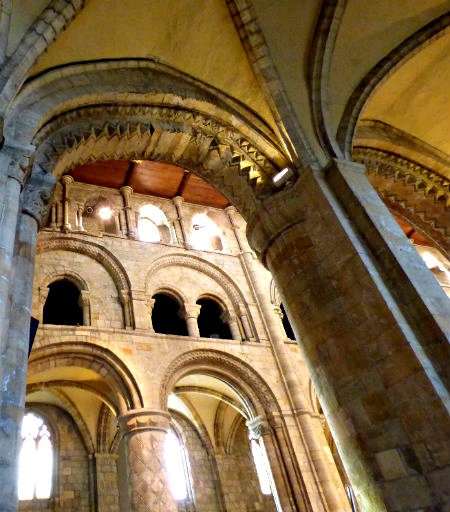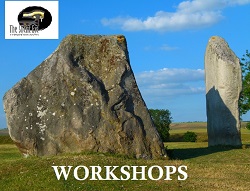
We walked down the Norman nave, passing Abbot Hugh’s pillar, identical to those at Durham cathedral where we had been the day before. Was it only the previous day? Similar too to the great carved columns of Dunfermline a few days earlier. For an unplanned trip, we seem to have followed a trail where several strands were interwoven in a continuous knot like the interlaced pattern of the Celtic stones.
***

We passed between the tombs of knights and their ladies… of bishops and dignitaries carved in stone to be remembered. How little we change, after all, across time and borders… how different in essence are our tombs and our desire to remain in human consciousness, to leave an indelible memory and our mark upon the world which is the cradle of our souls.
***

Near the Crossing a blackened wooden head… Christ or the Baptist perhaps… hangs on the wall. Its expression is one of both quiet joy and serenity. I can find no reference to dates or origin, but I wondered if the carving was a survival of one of the two fires that have devastated the church. Strange to think that without the apparent destruction, the building would not have evolved into the beauty it is today.
***

The Abbey has an unusual triple dedication to Our Lord, the Blessed Virgin Mary and St. Germain, the saint being seen as the patron of the church. His is an unusual story. He was born in the 378 or 380AD at Auxerre in France, and rose to military and social prominence. The Bishop of Auxerre saw in him a spiritual potential, but Germain resisted all attempts to turn him to the Church. The bishop kidnapped him, bound him and locked him in the church before shaving Germain’s head with the monastic tonsure. Oddly, Germain accepted this calmly and went on to become a monk and a truly saintly man.
***

He came to Britain and preached, converting many to Christianity and even led the British against the Picts and Scots to gain the bloodless “Alleluia Victory” in 430AD, where he had the concealed army cry the paean three times so loudly the enemy, thinking themselves outnumbered, turned and fled. Close to the town of Selby, a field is still known as Garmon Carr… Garmon was the name by which he was known in England. It is possible the saint visited the area. Oddly, given the trail of clues we had been following, Germain is thought to have been a teacher of St Patrick.
***

Germain was known for his dreams and visions. One of his major sermons in Britain was at St Albans, then Roman Verulamium, where St Alban, the first British Christian martyr, had been beheaded. Alban revealed himself to Germain in a vision and his cult grew from that point. It was another vision that sent St Benedict to Selby to found the Abbey. He dreamed that Germain had told him to found a great abbey at ‘Selebiae’ where three swans would mark the spot. After wandering far, Benedict found the bend in the Ouse where three swans alighted and the birds have been the symbol of the Abbey ever since.
***

Not all the monks from Selby were so saintly however, nor did they always follow the Rule of St Benedict to the letter. The thirteenth century saw visitations by various Archbishops who found that the resident bishop was failing in his ecclesiastical duties by not singing Mass, conducting prayer, or preaching. He wasn’t even turning up in the Chapter House for meetings. Though that may or may not have been worse than the findings of the previous Archbishop, called in to deal with the monks after complaints of their dealings with married women… How many stories could these walls still whisper?
***




it’s a pity they never listened to the words of Jesus, men and women being equals, amen
LikeLike
Equality across society? That would not serve the ambitious…
LikeLike